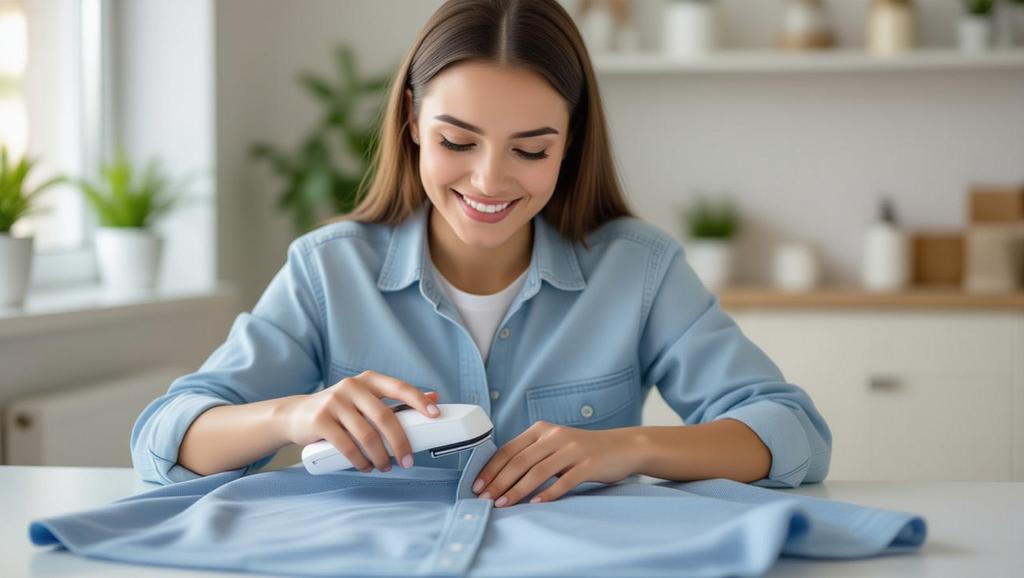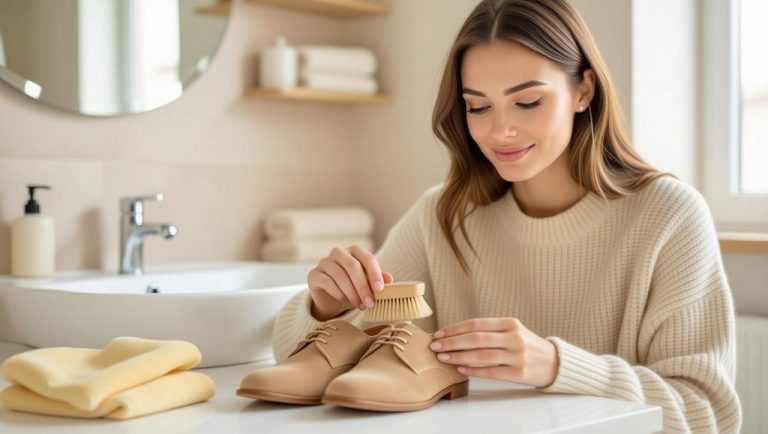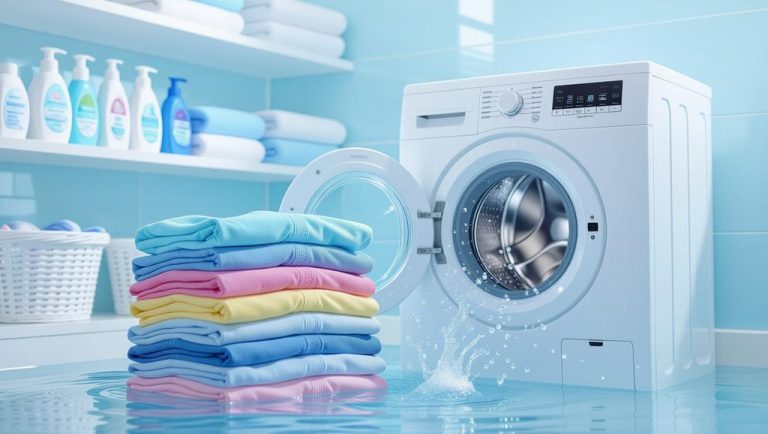What is Pilling and Why Does It Happen?
Pilling on fabrics is one of those frustrating things that happens to almost everyone’s clothes over time. From my own experience, I’ve noticed how these little balls of lint, called pills, start showing up on my sweaters after just a few wears. Basically, how to remove pilling from clothes involves understanding that pilling occurs when the fibers on the surface break and tangle together due to wear and tear. It’s like the fabric is getting tired from all the rubbing and washing we put it through.
In everyday life, this can happen from simple actions, such as your clothes brushing against a backpack or even just sitting on the couch. I remember once, my favorite cotton t-shirt got covered in pills after I wore it with a rough jacket. According to what I’ve read, it’s often caused by loose fibers clumping during washes, making remove fabric pills a common chore. Over the years, I’ve learned that fabrics like wool or acrylic are more prone to this because their shorter fibers don’t hold up as well as tighter weaves like denim.

To prevent clothing pilling, it’s helpful to know that friction speeds up the process, especially in the wash. In my opinion, it’s not just about fixing the problem but catching it early. For instance, when I sort my laundry, I try to separate delicate items to avoid extra abrasion. This way, you can keep your clothes looking newer for longer, which is why understanding the basics is key to maintaining your wardrobe.
Tools and Materials Needed for Removing Pilling
When it comes to tackling pilling, having the right tools makes all the difference, and I’ve gathered a few essentials from my own trials. First off, a fabric comb or a battery-operated pill remover is super handy because they gently scrape away those pesky lint balls without damaging the cloth. I always keep one in my laundry room since it’s quick and effective for how to remove pilling from clothes. These aren’t expensive, and you can find them at most stores.
Another must-have is a simple razor or even pumice stone, which might sound odd but works great in a pinch. From what I’ve tried, adhesive rollers are also fantastic for picking up pills, especially on smoother fabrics. Oh, and don’t forget things like tweezers or an old hair comb; they’re perfect for precise spots. In my experience, using household items saves time and money, but you have to be careful not to overdo it and tear the fabric.
Plus, if you’re dealing with larger areas, sandpaper or the abrasive side of a sponge can do the trick, though it’s a bit rougher. I once used a piece of velcro from an old project, and it actually worked well for removing fuzz. Remember, the goal is to have a set of tools that are easy to use, so maybe start with basics like a lint remover and build from there. This approach has helped me keep my clothes in better shape without much fuss.
Step-by-Step Guide to Remove Pilling from Clothes
Using a Fabric Shaver
If you’re new to this, using a fabric shaver is probably the easiest way to get started on remove fabric pills. First, lay your clothing flat on a table so it’s stable, then turn it inside out to protect the outer layer. In my experience, this step prevents any accidental damage while shaving off the pills. Next, hold the shaver at a slight angle and gently go over the affected areas, collecting the lint in its built-in compartment. It’s satisfying to see the fabric smooth out right away.
Make sure to go slowly and not press too hard, as that could weaken the material. For example, I once fixed a pilled sweater in under five minutes this way, and it looked almost brand new. After you’re done, give it a quick brush with your hand to check for any missed spots. This method is great for knits and soft fabrics, and I’ve found it really reduces the need for more invasive fixes.
Read more Fashion hacks to save time on busy mornings
Overall, it’s a reliable technique that keeps your clothes wearable.
One more tip: always test on a small area first, especially if the garment is delicate. I’ve learned from mistakes where I rushed and ended up with a small hole, so patience is key. Once finished, wash the item gently to remove any loose fibers, and you’ll notice a big improvement in its appearance.
Using a Razor or Pumice Stone
Another straightforward approach is using a razor, which I use when I don’t have a fabric shaver around. Start by stretching the fabric taut over a flat surface to make the pills stand out. Then, carefully glide the razor over the pills in short, upward strokes—remember, a dull blade works better to avoid cuts. From my own trials, this has saved me on old jeans where pilling was bad, but you have to be extra cautious with thinner materials.
A pumice stone is similar and works well for bulkier items like wool blankets. Just rub it lightly in circles until the pills come off, but don’t overdo it or you might fray the edges. For instance, I fixed a friend’s scarf this way, and they were amazed at the results. It’s a bit more manual than a shaver, so it takes longer, but it’s effective for prevent clothing pilling in the long run by removing the buildup.
Afterward, inspect the fabric and use a soft brush to clear away debris. In my opinion, this method is ideal for quick fixes, though it’s not as precise. I’ve used it on several occasions, and as long as you’re gentle, your clothes will look refreshed without much effort.
Other Household Methods
If you don’t have specialized tools, there are plenty of household hacks that work just as well. For starters, an adhesive roller or even tape wrapped around your finger can pick up pills easily—just dab it over the fabric. I often do this with my casual wear, and it’s surprisingly effective for light pilling. Another option is using a fine-tooth comb, like a lice comb, which I keep for my wool items; run it gently across the surface to snag the pills.
You can also try rubbing with an old nylon stocking or the abrasive side of a sponge. In one case, I used a stocking on a plaid shirt, and it pulled off the fuzz without any issues. These methods are great because they’re free and accessible, but they require a steady hand to avoid damaging the cloth. For example, if the pilling is stubborn, combining it with an iron on low heat can help smooth things out.
Lastly, sandpaper is useful for larger areas, though I only use it on tougher fabrics. Remember to go lightly and in one direction. From what I’ve seen, these tricks not only remove the pills but also make your clothes feel softer, making it a practical way to handle how to remove pilling from clothes when you’re in a bind.
Tips to Prevent Pilling on Your Clothes
Preventing pilling is just as important as removing it, and over the years, I’ve picked up some habits that really help. First, always wash your clothes inside out and use a gentle, cold cycle to reduce friction—hot water can wear out fibers faster, making them more susceptible. In my wardrobe, I sort by fabric type, like keeping knits separate from denims, which cuts down on abrasion during laundry.
Choosing the right fabrics is key too; go for tightly woven materials like linen or rayon instead of loose knits. For instance, prevent clothing pilling becomes easier if you avoid overloading the dryer, as tumbling can cause more rubbing. I’ve started air-drying my delicates, and it makes a noticeable difference. Also, using detergents with enzymes, like cellulase, can help loosen pills during washes, which I’ve tried and it works wonders.
Another tip is to minimize daily friction, such as not wearing backpacks over sensitive tops. In my daily routine, I layer clothes carefully to prevent rubbing, and it’s helped extend the life of my favorites. By following these steps, you can keep pilling at bay and maintain your clothes better overall.
Conclusion
In conclusion, dealing with pilling doesn’t have to be a hassle once you know the tricks. From using a fabric shaver to simple household items, how to remove pilling from clothes is something anyone can master with a bit of practice. I’ve shared these methods because they are the real game-changers for keeping your wardrobe in top shape, and in my experience, preventing it is even better.
Remember, it’s all about being proactive with your laundry routine and choosing durable fabrics. While pilling might still happen occasionally, these tips will make it less of a problem. Personally, I feel more confident in my clothes now, and I hope this helps you too—happy maintaining!












